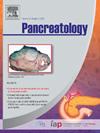Critical appraisal of postpancreatectomy hemorrhage after pancreatoduodenectomy: an analysis of risk factors, treatment and outcomes in 860 consecutive cases
IF 2.7
2区 医学
Q2 GASTROENTEROLOGY & HEPATOLOGY
引用次数: 0
Abstract
Background
Postpancreatectomy haemorrhage (PPH) is an important and potentially life-threatening complication after pancreatoduodenectomy (PD). The aim of this study is to characterize PPH in a single institutional cohort of patients who underwent PD and analyse the incidence, risk factors, treatment and outcomes of PPH.
Methods
We performed a retrospective analysis of 860 consecutive patients who underwent PD between January 1997 and July 2021 at a tertiary referral centre. Key perioperative data and outcome measures were analysed for all patients who developed PPH.
Results
A total of 108 patients (12.6 %) developed PPH, of which 95 patients (88.0 %) had late PPH with the median onset on postoperative day 8. Multivariate analysis revealed that pancreatogastrostomy (PG) anastomosis, intraoperative blood loss >1000 mL and postoperative pancreatic fistula (POPF) grades B and C were independent predictors of late PPH. The majority of patients with intraluminal PPH (42.6 %) underwent endoscopy as first-line intervention while most patients with extraluminal PPH underwent initial surgical haemostasis (40.7 %) and initial angiography (16.7 %). Pancreatojejunostomy anastomosis was associated with a higher rate of POPF compared to PG, although PG was associated with a higher incidence of PPH.
Conclusion
The optimal approach to treatment of PPH takes into account location, timing and severity of the bleeding as well as the type of pancreatoenteric anastomosis. Appropriate treatment strategies for both early and late PPH include angiography, endoscopy, reoperation and conservative management or a combination of them.
860例连续病例胰十二指肠切除术后出血的危险因素、治疗和结局分析
背景:胰腺切除术后出血(PPH)是胰十二指肠切除术(PD)后重要且可能危及生命的并发症。本研究的目的是在单一机构的PD患者队列中描述PPH的特征,并分析PPH的发病率、危险因素、治疗和结局。方法:我们对1997年1月至2021年7月在三级转诊中心连续接受PD治疗的860例患者进行了回顾性分析。分析所有发生PPH的患者围手术期的关键数据和结局指标。结果:共108例(12.6%)发生PPH,其中95例(88.0%)为晚期PPH,中位发病时间为术后第8天。多因素分析显示,胰胃吻合术、术中出血量>1000 mL和术后胰瘘(POPF)分级B级和C级是晚期PPH的独立预测因素。大多数腔内PPH患者(42.6%)接受内镜作为一线干预,而大多数腔外PPH患者接受初始手术止血(40.7%)和初始血管造影(16.7%)。与PG相比,胰空肠吻合术与更高的POPF发生率相关,尽管PG与更高的PPH发生率相关。结论:PPH的最佳治疗方法应考虑出血部位、时间、严重程度及胰肠吻合方式。早期和晚期PPH的适当治疗策略包括血管造影、内窥镜检查、再手术和保守治疗或两者结合。
本文章由计算机程序翻译,如有差异,请以英文原文为准。
求助全文
约1分钟内获得全文
求助全文
来源期刊

Pancreatology
医学-胃肠肝病学
CiteScore
7.20
自引率
5.60%
发文量
194
审稿时长
44 days
期刊介绍:
Pancreatology is the official journal of the International Association of Pancreatology (IAP), the European Pancreatic Club (EPC) and several national societies and study groups around the world. Dedicated to the understanding and treatment of exocrine as well as endocrine pancreatic disease, this multidisciplinary periodical publishes original basic, translational and clinical pancreatic research from a range of fields including gastroenterology, oncology, surgery, pharmacology, cellular and molecular biology as well as endocrinology, immunology and epidemiology. Readers can expect to gain new insights into pancreatic physiology and into the pathogenesis, diagnosis, therapeutic approaches and prognosis of pancreatic diseases. The journal features original articles, case reports, consensus guidelines and topical, cutting edge reviews, thus representing a source of valuable, novel information for clinical and basic researchers alike.
 求助内容:
求助内容: 应助结果提醒方式:
应助结果提醒方式:


